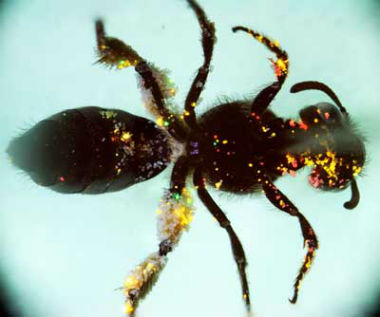|
NOVIDADES
A pollination biologist from Stellenbosch University in South Africa is using quantum dots to track the fate of individual pollen grains. This is breaking new ground in a field of research that has been hampered by the lack of a universal method to track pollen for over a century. In an article published in the journal Methods in Ecology and Evolution ("Using quantum dots as pollen labels to track the fate of individual pollen grains"), Dr Corneile Minnaar describes this novel method, which will enable pollination biologists to track the whole pollination process from the first visit by a pollinator to its endpoint - either successfully transferred to another flower's stigma or lost along the way.  This bee was caught after it visited a flower of which the pollen grains were labelled with quantum dots. Under the microscope one can see where the pollen was placed, and actually determine which insects carry the most pollen from which flower. (Image: Corneile Minnaar)
Starting in 2015, Minnaar decided to tread where many others have thus far failed, and took up the challenge through his PhD research in the Department of Botany and Zoology at Stellenbosch University (SU). "Most plant species on earth are reliant on insects for pollination, including more than 30% of the food crops we eat. With insects facing rapid global decline, it is crucial that we understand which insects are important pollinators of different plants--this starts with tracking pollen," he explains. He came upon the idea for a pollen-tracking method after reading an article on the use of quantum dots to track cancer cells in rats (https://doi.org/10.1038/nbt994). Quantum dots are semiconductor nanocrystals that are so small, they behave like artificial atoms. When exposed to UV light, they emit extremely bright light in a range of possible colours. In the case of pollen grains, he figured out that quantum dots with "fat-loving" (lipophilic) ligands would theoretically stick to the fatty outer layer of pollen grains, called pollenkitt, and the glowing colours of the quantum dots can then be used to uniquely "label" pollen grains to see where they end up. The next step was to find a cost-effective way to view the fluorescing pollen grains under a field dissection microscope. At that stage Minnaar was still using a toy pen from a family restaurant with a little UV LED light that he borrowed from one of his professors. "I decided to design a fluorescence box that can fit under a dissection microscope. And, because I wanted people to use this method, I designed a box that can easily be 3D-printed at a cost of about R5,000, including the required electronic components." So far, the method and excitation box have proven itself as an easy and relatively inexpensive method to track individual pollen grains: "I've done studies where I caught the insects after they have visited the plant with quantum-dot labelled anthers, and you can see where the pollen is placed, and which insects actually carry more or less pollen." But the post-labelling part of the work still requires hours and hours of painstaking counting and checking: "I think I've probably counted more than a hundred thousand pollen grains these last three years," he laughs. As a postdoctoral fellow in the research group of Prof Bruce Anderson in the Department of Botany and Zoology at Stellenbosch University, Minnaar will continue to use the method to investigate the many unanswered questions in this field. Stellenbosch University (South Africa). Posted: Feb 14, 2019. |
|||||||||||||||||||||||||